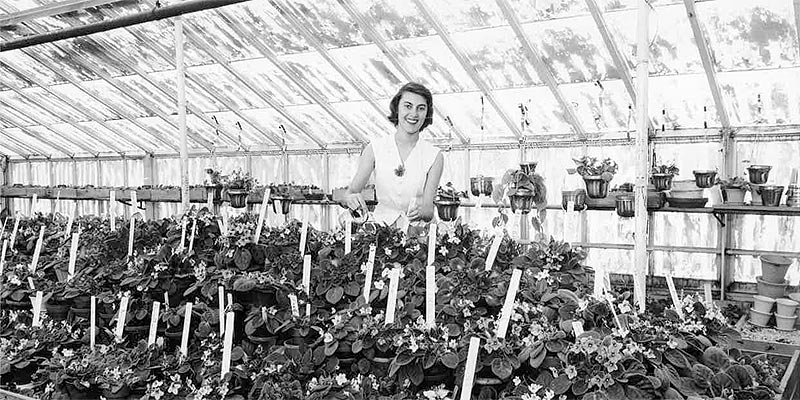African Violets

In the early years, Behnke Nurseries became rightly famous for its African violets. This all began many years ago when Albert and Rose Behnke’s young daughter Sonja, (who recently retired as President of Behnke Nurseries) received a gift from a friend. It was a dark blue African violet called ‘Blue Boy’. Rose and Albert were intrigued with this beautiful little plant that never seemed to stop blooming. Behnke Nurseries soon began selling African violets and Rose became involved with the hybridization of the plants, developing the `Behnke Boy’ and `Washington Star’ varieties and several others.
African violets (Saintpaulia ionantha) were once limited to the forest floors on the eastern coast of Africa, but are now one of the most common house plants the world over. African violet flowers are available in many different shades of white, pink, blue, and violet, and some are even bicolor or have contrasting edge colors. The flowers can be single, semi-double, or double and have either smooth or ruffled edges. While violet leaves are typically fleshy, hairy, and dark green in color, several varieties are now available with variegated leaves, usually green speckled with white or sometimes even flashed in pink, and come in a selection of quilted or ruffled forms.
African violets come in a range of sizes from the diminutive miniature varieties that are less than 6 inches in diameter, to dwarf, standard, and to very large varieties, some reaching over 16 inches in diameter. Trailing varieties are also available and are perfect for hanging baskets. Although Behnke’s does not always have all of these different varieties in stock, we currently have many beautiful specimens to add to your collection or to start a new one.
Providing the proper light levels for your African violets will ensure that they remain healthy and provide you with a nearly constant show of beautiful flowers. They will grow best in a bright indirect light, such as a sunny window with a sheer curtain drawn over it to protect the leaves from the scorching effects of full sun. Violets also do very well under florescent lights. Florescent tubes specifically designed for plants are readily available, but many people have had good luck with regular florescent lights, which are cheaper.
There is another critical aspect to the care of your violets. Too much or too little water can be harmful to the plant. One excellent technique is to place your individually potted African Violets on a shallow watertight tray filled with gravel. Always bring the water to room temperature since cold water may cause damage and spots if it were to accidentally splash onto the leaves. Water your violets when the soil just begins to dry. Excess water will drain into the tray but the layer of gravel will keep the plants from setting directly in the water. The water under the gravel will evaporate, providing all important humidity, critical to growing truly beautiful violets.
Fertilize twice a month with a water soluble fertilizer. Behnke’s carries a fertilizer specifically formulated to ensure healthy plant growth and almost non-stop bloom.Use porous, sterilized soil, high in organic matter. A mix of one part perlite, two parts vermiculite and three parts peat moss will make for a well drained, light mix that will still retain adequate moisture. Specially prepared African violet soil mixes are available in the houseplant department at Behnke Nurseries. These are very convenient, consistent in quality, and free of pests and soil born diseases.African violets thrive at temperatures that most modern houses are kept at, somewhere between 65 and 80 degrees.
Try not to subject your plants to sudden or extreme temperature changes. Good air circulation will help prevent fungal disease but it is a good idea to keep your violets out of drafts.African violets are susceptible to several diseases and pests, such as aphids, mites, botrytis blight and rot. The best defense against most of these problems is to maintain ideal growing conditions for your plants, as outlined above. Maintaining an air space around your individual plants will minimize spreading of disease if one of your plants were to develop problems. Carefully remove damaged leaves, and the stalks of spent flowers, these are breeding grounds for fungal diseases.
Behnke’s staff of houseplant experts will be able to assist you with any specific problems that your plants may develop.

This Post Has 0 Comments